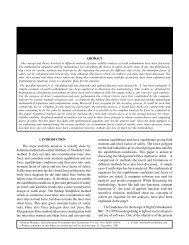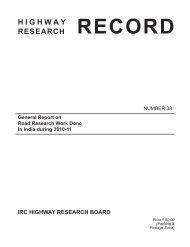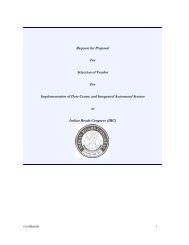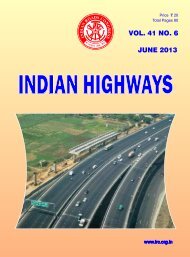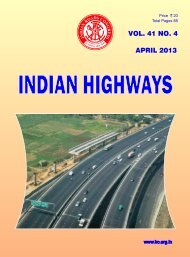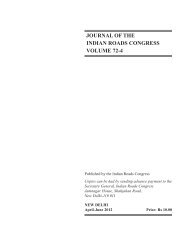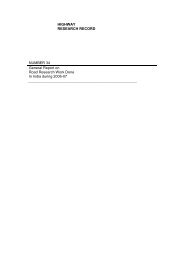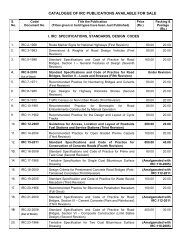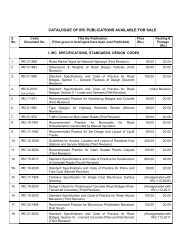Highway Research Record No. 39 - Indian Roads Congress
Highway Research Record No. 39 - Indian Roads Congress
Highway Research Record No. 39 - Indian Roads Congress
Create successful ePaper yourself
Turn your PDF publications into a flip-book with our unique Google optimized e-Paper software.
angle of friction. A combination of WRP and cinder can<br />
satisfy density requirements of the materials for the<br />
embankment construction.<br />
Significance/ Utilisation Potential<br />
Interim results show that cinder waste material can be<br />
used in embankment for road construction.<br />
Further information/Copy of report can be obtained<br />
from<br />
address: The Head, Geotechnical Engg. Division,<br />
CSIR- Central Road <strong>Research</strong> Institute, New Delhi -<br />
110025, Mobile: 9868858380, phone: 26832173, Fax:<br />
011-26845943, e-mail ID: vittal.crri@gmail.com<br />
11. Suitability of Granular Materials for Capillary<br />
Cut-Off<br />
Keywords: capillary cut-off, Sub grade,<br />
geotextile<br />
Date of Start: July 2011<br />
Date of Completion (Targeted): March. 2012<br />
I.<br />
II.<br />
PWD, Jhajjar, Haryana.( S)<br />
Central Road <strong>Research</strong> Institute, New Delhi<br />
(R)<br />
Scope and Objectives<br />
To assess the suitability of locally available granular<br />
materials, locally known as Tibba sand for the<br />
construction of embankment, sub grade and capillary<br />
cut-off.<br />
Methodology<br />
A stretch of about 4.2 km length of NH-71 near Jhajjar<br />
in Haryana experiences frequent failures due to low<br />
embankment height of the road and presence of an<br />
canal adjacent to this road at this location. The subgrade<br />
soil of this road gets saturated and subsequently it<br />
results in failure. The water from canal saturates the<br />
sub grade layer by capillary action. To rectify this<br />
problem, it was decided that the height of embankment<br />
be raised and a capillary cut-off layer be provided. For<br />
this, locally available materials commonly known as<br />
Tibba sand and GSB materials were investigated for the<br />
construction of embankment, sub grade and capillary<br />
cut-off. It was observed that Tibba sand may be used<br />
for the construction of embankment and a mix of Tibba<br />
sand and soil can be used for sub grade construction.<br />
Interim Conclusions/ Supporting Data<br />
Granular materials, available locally, did not satisfy the<br />
required filter/drainage specifications for capillary cut-<br />
ROAD RESEARCH IN INDIA 2011-12 37<br />
off. However, these materials may be used along with<br />
geosynthetic materials for construction of capillary cut.<br />
Significance/ Utilisation Potential<br />
Raising of the embankment height has now been taken<br />
up based on CRRI recommendations.<br />
Further information/Copy of report can be obtained<br />
from<br />
address: The Head, Geotechnical Engg. Division,<br />
CSIR- Central Road <strong>Research</strong> Institute, New Delhi -<br />
110025, Mobile: 9868858380, phone: 26832173, Fax:<br />
011-26845943, e-mail ID: vittal.crri@gmail.com<br />
12. Feasibility Study on Utilisation of<br />
Phosphogypsum as Road Construction<br />
Material<br />
Keywords: Phosphogypsum, Fly ash, concrete<br />
road, Bituminous mixes<br />
Date of Start: April. 2011<br />
Date of Completion (Targeted): June. 2012<br />
I. M/s Paradeep Phosphates Ltd., Orissa,<br />
India<br />
II. CSIR- Central Road <strong>Research</strong> Institute,<br />
New Delhi (R,I)<br />
Scope and Objectives<br />
In order to assess suitability of Phosphogypsum as a<br />
road construction material, a laboratory study has been<br />
taken up. The broad scope of work is as follows:<br />
•<br />
•<br />
•<br />
•<br />
Characterization of Phosphogypsum<br />
Characterization of locally available Soil /Fly ash<br />
and Phosphogypsum mixes<br />
Use of Phosphogypsum in concrete roads<br />
Use of Phosphogypsum in Bituminous mixes of<br />
flexible pavements.<br />
Methodology<br />
To carry out the study, Phosphogypsum samples<br />
and locally available soil was collected. The locally<br />
available soil is fine grained soil and clayey in nature.<br />
Since fly ash is available in plentiful nearby, mixes of<br />
phosphogypsum and fly ash at various proportions have<br />
also been characterised. Physical and engineering<br />
properties of phosphogypsum as such and mixes of<br />
Phosphogypsum and soil/ fly ash have been determined<br />
in CRRI laboratory. The properties determined include<br />
specific gravity, particle size distribution, consistency<br />
limits such as liquid limit and Plastic limit, OMC and<br />
MDD, etc. The strength and engineering characteristics



